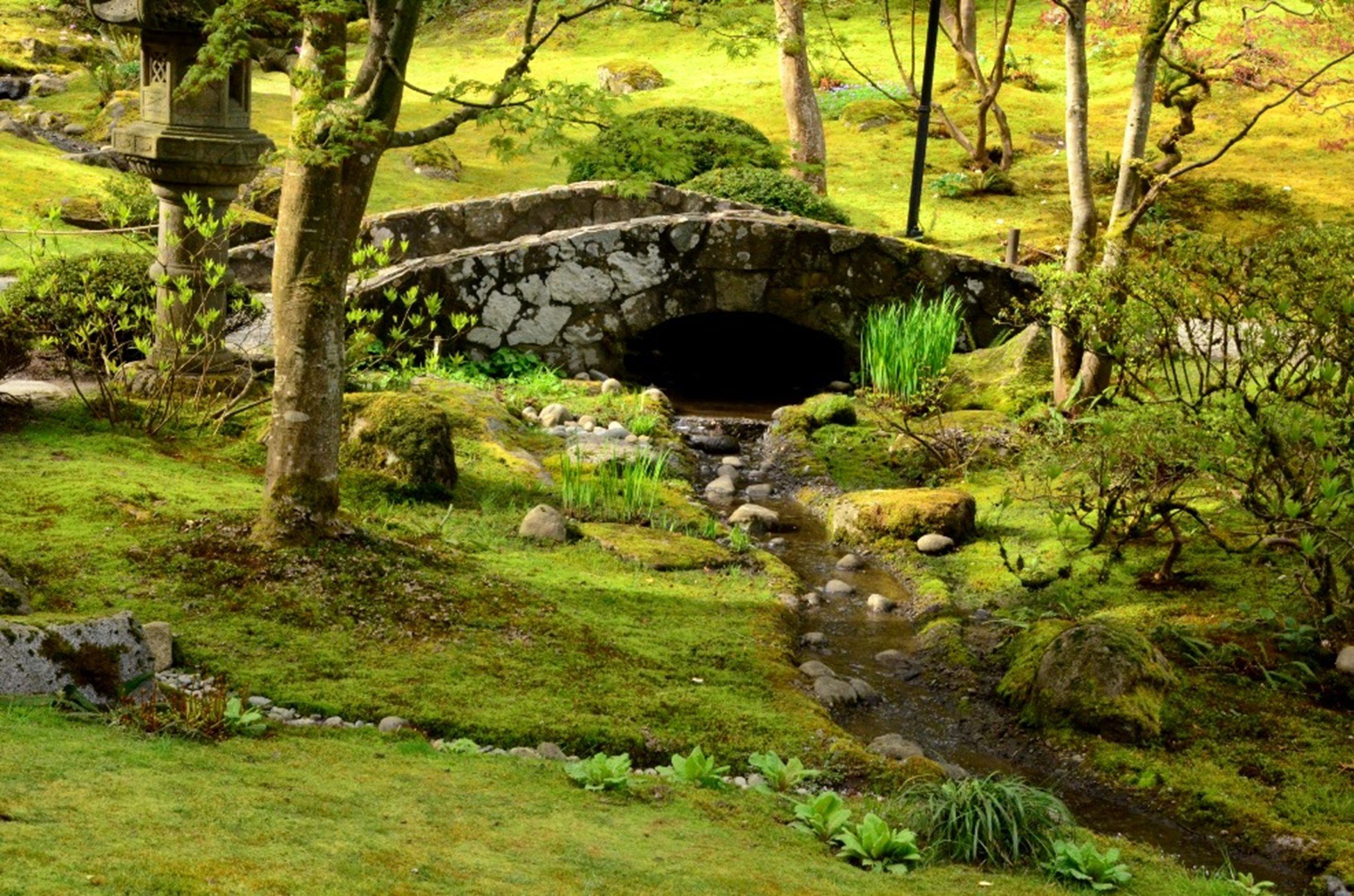The Color Green in the Seattle Japanese Garden
By Corinne Kennedy
Japanese maple leaves in the Seattle Japanese Garden. (photo: David Rosen)
“it is with awe
that I beheld
fresh leaves, green leaves,
bright in the sun
- Basho
”
Green has long been a basic element and the most important color of Japanese gardens—more important than the fleeting vibrancy of colored flowers or foliage. This is reflected throughout the seasons in our Seattle Japanese Garden. Evergreens—notably conifers, broadleaf evergreens, and groundcovers—provide structure throughout the year. Important Japanese plant species include pine, hinoki false cypress, camellia, evergreen azalea, bamboo, low-growing grass-like plants, and mosses. Japanese maples and cherry trees contribute seasonal shades of green as well as vibrant spring and fall colors.
Mosses cover the ground. (photo: Larry St. Pierre)
In the Pacific Northwest, unlike much of the U.S., winter envelops us with greenness—despite bare branches and open areas where herbaceaous (perennial, non-woody) plants have gone underground for the season. As in other Japanese-style gardens, our Garden’s soil remains mostly covered by low-growing, green-leaved groundcovers. Even in the grayness of Seattle’s rainy winter, we discern myriad shades of green. Conifers and broadleaf evergreens reveal their subtle beauties. Mosses and lawns display their lush greenness.
Spring brings the emergence of brighter chartreuse-greens as deciduous plants leaf out, and perennials emerge. These green shades bring balance to the vibrancy of newly-opened maple leaves and to the many bright colors of flowering trees & shrubs.
Green reflections across the pond. (photo: David Rosen)
The beginning of summer brings a renewed subtlety to the Seattle Japanese Garden, as it does to the gardens of Japan. Spring-blooming trees, shrubs and non-woody plants have shed their flowers, and the new foliage of many maples matures from bronze and red tones to their subtler summer greens. Even in the case of woody evergreens, paler new foliage has matured to darker shades. Without the distraction of brightly colored flowers, visitors are more likely to notice the lush greens of ferns and the creeping mosses that cover soil, stones, and the trunks of trees. Green becomes the predominant color, evoking feelings of peacefulness and serenity.
In autumn, the leaves of many deciduous trees and shrubs—notably Japanese maples—turn vibrant colors before they fall. Berries add spots of brightness. The greenness of the garden’s many evergreens and still-green deciduous plants endures, but is no longer prominent.
How this inherent greenness affects Japanese garden visitors has been analyzed by Heather Blum, a registered nurse with a degree in biochemistry (Sukiya Living Magazine, November/December, 2017):
“I found that there is a profound mind-body response to ‘green’ unlike any other color in the visible light spectrum. Japanese gardens are predominantly green in color, which is one reason why we respond differently in that environment than in any other type of garden.”
According to Blum, gardens with vibrant colors—reds, yellows & oranges—are stimulating and energizing, releasing adrenaline and elevating blood pressure & heart rate. At the other end of the color spectrum, purples & blues announce a royal solemnity. In the middle of the spectrum is green, “the most restful color to the eye as it requires no retinal adjustment to focus on it.” The natural color of foliage, “it makes us feel stable and secure.” Thus, she asserts, it promotes balance and relaxation—a state of calmness and healing, free from tension.
Raindrops, and the many shades of green on hosta foliage. (photo: Riley Sawyered)
Green, of course, is the predominant color of leaves, where plant chlorophyll is most concentrated. Shade plants are usually darker green because they require more of this pigment than plants growing in sun. In the process of photosynthesis, chlorophyll captures light energy, which is used to convert water, carbon dioxide and minerals into oxygen and energy-rich organic compounds. It’s been called “the driving force behind life on earth” (Emeralds, by Karen Platt, 2005).
Around the world, the color green has developed varied meanings. The Japanese word for green (midori) is also the word for vegetation. There, green represents the energy of life and growth. In addition, it is most often associated with temple gardens. Many of these temple gardens have been transformed by the forces of nature from their original design, becoming greener with the passage of time. Native moss species introduced themselves, and began to spread—aided by neglect, as well as by gardeners who maintained the conditions that the mosses required. Saiho-ji in Kyoto, known as kokedera (translated as “moss temple”), is the most famous of these “moss gardens.” In the Pacific Northwest, the 150-acre Bloedel Reserve, on Bainbridge Island, is renowned for its greenness and its garden of mosses.
In Seattle, the seasons are less distinct than in Japan, and our climate is markedly different. However, the greenness of the Seattle Japanese Garden connects it—across the Pacific and the centuries—to Japan and to our garden heritage. Green, the color of serenity and peacefulness, endures, spanning the seasons and the oceans.
Corinne Kennedy is a Garden Guide, a frequent contributor to the Seattle Japanese Garden blog, and a retired garden designer. This article is a lightly edited version of one originally posted in May 2018.




